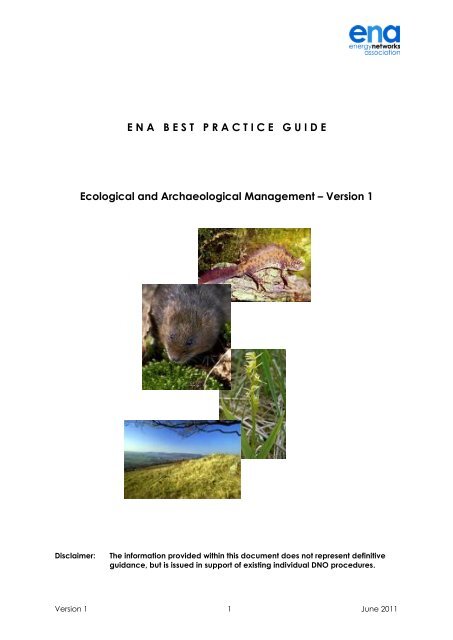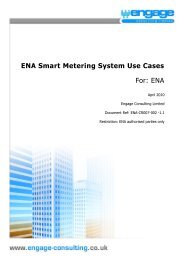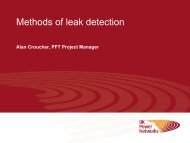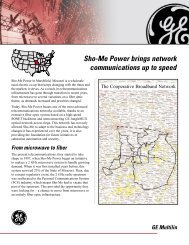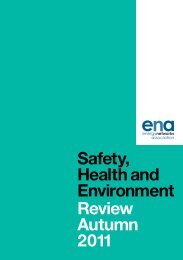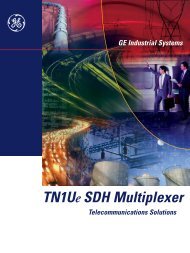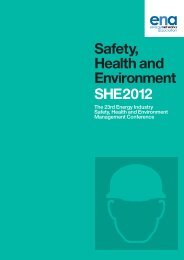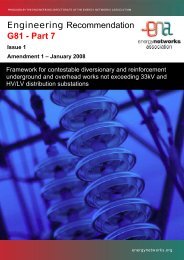ENA BEST PRACTICE GUIDE - Energy Networks Association
ENA BEST PRACTICE GUIDE - Energy Networks Association
ENA BEST PRACTICE GUIDE - Energy Networks Association
- No tags were found...
Create successful ePaper yourself
Turn your PDF publications into a flip-book with our unique Google optimized e-Paper software.
E N A B E S T P R A C T I C E G U I D EEcological and Archaeological Management – Version 1Disclaimer:The information provided within this document does not represent definitiveguidance, but is issued in support of existing individual DNO procedures.Version 1 1 June 2011
ContentsSection Title Target Audience1.0 Introduction1.1 <strong>Energy</strong> <strong>Networks</strong> <strong>Association</strong>All Employees1.2 Electricity Act, Schedule 9 statement1.3 Key legislation Environment Team,1.4 The need to plan ahead1.5 Communications2.0 Planning and Design2.1 Methods for Identification2.2 Consultation2.3 Licences (including compliance)2.4 Wildlife Management2.4.1 Survey Licence2.4.2 Development Licence2.4.3 Conservation Licence2.5 Licence Holder Responsibilities2.5.1 Compliance with licences2.5.2 Working adjacent towatercourses2.6 Archaeological Management2.6.1 Scheduled Monuments2.6.2 Archaeological Priority Areas2.6.3 Finds of gold, silver and humanremains3.0 Site Works3.1 Site ManagementWayleave / ConsentsTeam,Planners, Site ManagersEnvironment Team,Wayleave / ConsentsTeam, PlannersEnvironment Team,Wayleave / ConsentsTeamEnvironment Team,Wayleave / ConsentsTeam, Site ManagersEnvironment Team,Wayleave / ConsentsTeamSite Managers, PlannersSite Management4.0 Record Management Environment Team,Wayleave / ConsentsDocument Manager5.0 AppendicesEnvironment TeamA Desk Survey ChecklistWayleave / ConsentsB Site Walkover Checklist / GuideC Species Information Sheets All EmployeesD Example Licence Environment TeamE Survey Guidance Chart Planners, EnvironmentTeam6.0 References Environment TeamVersion 1 2 June 2011
1.0 Introduction1.1 <strong>Energy</strong> <strong>Networks</strong> <strong>Association</strong>This Document is produced in partnership with the <strong>Energy</strong> <strong>Networks</strong><strong>Association</strong> and all member organisations of the Environmental Committee.• This document is owned by the <strong>ENA</strong> Environment Committee and willbe reviewed bi-annually as a minimum or following the introduction ofnew legislation or best practice.It provides an overview of ecological and archaeological management,useful for project and environmental managers / advisors as well asoperational staff. Specifically the document aims to;• Provide a general awareness of legal compliance• Provide information on the process of managing ecologically sensitiveand archaeologically important sites• Identify key activities and contacts to ensure the successfulmanagement of ecologically sensitive and archaeologically importantsites.• Ensure that best practice is maintained throughout the U.K ElectricityDistribution NetworkMost development sites will have some ecological or archaeological interest,whether they are situated in rural or urban areas. Important sites aredesignated, although any site may have a wildlife / archaeological interest.At designated sites more care needs to be taken during the developmentprocess. Wherever there is ecological / archaeological value at a site, thisshould be identified and recorded and the potential adverse impacts on itavoided, or reduced to a minimum.1.2 Electricity Act, Schedule 9As stated in the Act:In formulating any relevant proposals, a licence holder or a person authorisedby exemption to generate or supply electricity;(a) shall have regard to the desirability of preserving natural beauty, ofconserving flora, fauna and geological or physiographical features of specialinterest and of protecting sites, buildings and objects of architectural, historicor archaeological interest; and(b) shall do what he reasonably can to mitigate any effect which theproposals would have on the natural beauty of the countryside or on anysuch flora, fauna, features, sites, buildings or objects.Version 1 3 June 2011
1.3 Key legislation;The following legislation exists to ensure the protection of sites and speciesthroughout the UK. In complying with this legislation we can ensure that thedisturbance to protected and valuable sites is minimised;• Wildlife and Countryside Act 1981 (WCA)• Countryside and Rights of Way Act 2000 (CRoW Act)• Burial Act / Ancient Monuments and Archaeological Areas Act 1979• Conservation of Habitats and Species Regulations 2010• Protection of Badgers Act 1992• Environmental Damage (Prevention and Remediation) Regulations2009• The Hedgerows (Amendment)(England) Regulations 2003This list is not exhaustive, for further details and specific legislativerequirements please refer to DNO company policies and managementsystems.Key MessageAll DNO’s have a legal responsibility to ensure the ongoing preservation andprotection of designated sites and protected species of flora and faunaVersion 1 4 June 2011
1.4 The Need to Plan AheadPlanning guidance across the UK makes it clear that nature and heritageconservation is fundamental in determining a planning application.Statutory authorities advise that surveys should be undertaken before seekingplanning permission, so that development is designed to avoid any impactson protected species.Leaving surveys until a later stage increases the risk that plans for thedevelopment will have to be redesigned or halted (temporarily orpermanently) if protected species or archaeological remains / artefacts arefound. In such cases, works would have to wait until surveys and anymitigation has been completed. This process can be very complex and timeconsuming. In the case of protected species, this can usually only beconducted at specific times of the year (see Appendix E), in most casesdelays will last several weeks or months.To avoid extensive delays surveys should be conducted as early as possible inthe planning process. If protected species or archaeological remains /artefacts are found the following may need to be considered:• Alternative sites or changes to the development footprint.• Mitigation and / or compensation may need to be designed andplanned (where impacts are unavoidable)• A licence and / or consents from (in England) Natural England (NE),the Environment Agency (EA), English Heritage (EH) etc. (or theirequivalent bodies in Wales, Scotland and Northern Ireland)mayneed to be obtained.The above points should be considered before the start of any works thatmay impact upon protected species, designated sites or areas ofarchaeological interest.Key MessageIt is not of benefit to either species conservation, archaeological heritage orthe industry to rely on last minute mitigation.Version 1 5 June 2011
1.5 CommunicationsIn order to gather as much relevant information as possible with regards to apotential site it is worth considering contacting the following groups;• Internal – company recording system for historical data (EMU, Magicetc)• External / Third Parties – local councils, wildlife and resident groups,Natural England, Countryside Council for Wales etc.• Other Utilities – Highways Authorities and Utilities Committee (HAUC)• Lessons Learnt – Other DNO experience via <strong>ENA</strong> EnvironmentalCommitteeThe absence of information or data however does not mean that importantfeatures, species or habitats do not occur on a site.Key MessageEfficient and thorough planning is the key to successfully managingecological and archaeological issues on site.Version 1 6 June 2011
2.0 Planning and DesignTo ensure successful and timely management there are five key areas tofocus upon• Methods for identification• Consultation with relevant authorities• Licence application and compliance• Appropriate site supervision / site management• Necessary records to be kept following site completion2.1 Method for identificationIdentification Resources (not exhaustive)• Existing network records• Place names (Gas Hill, Tannery Lane, Badger Ridge etc)• Maps / watercourses / Special Protection Zones (SPZs)• Existing Environmental Impact Assessments (EIAs)• Statutory organisations (English Heritage / Natural England /Countryside Council for Wales / Scottish Natural Heritage, CADWin Wales)• Local Wildlife Trusts, Historic Societies and Local Biological RecordsOffice• Website Resources e.g. Magic, EMU etc• Land owner knowledge• Observation (ongoing throughout duration of works)Identification StagesDesk surveyStage 1Site WalkoverStage 2Site ReportStage 3This should use current and historic evidence todetermine the potential impact of the project on theenvironment. The checklist detailed in Appendix Ashould be used to ensure adequate data is obtained.Following the desk study a site walkover should becarried out if required. This should gather further detailon any issues raised by the desk study and presentfurther information including photographs – seeAppendix B. The crib sheet provided in Appendix Ccan be used as a guide when undertaking sitewalkovers.On completion of the site walkover a site report shouldbe produced detailing the following:Information from Stages 1 & 2Version 1 7 June 2011
If any further work is required to determine the extent ofany risks e.g. wildlife surveys, intrusive investigation, soilsampling etc then specialist consultants should be used.Links to relevant policies, procedures and riskassessments should be included in any report forreference throughout the project.This report should be made available to any partiesundertaking work on the site.2.2 ConsultationIf protected areas or species have been identified and / or could potentiallybe at risk, consultation with statutory authorities or a professional consultantmust be undertaken at the earliest opportunity.Archaeological Statutory AuthoritiesEnglish HeritageCADWHistoric ScotlandEnvironment and Heritage Service – Natural Heritage (Northern Ireland)Local Coroner (Human remains)Ecological Statutory AuthoritiesNatural EnglandCountryside Council for WalesScottish Natural HeritageEnvironment and Heritage Service – Natural Heritage (Northern Ireland)Other statutory authorities to be consultedEnvironment Agency (EA)Scottish Environmental Protection Agency (SEPA)Environment and Heritage Service – Natural Heritage (Northern Ireland)Regional Water CompaniesLocal Authorities (Biodiversity Officer, Environmental Health Officer, PlanningOfficer) including Royal ParksWelsh AssemblyDepartment of Environment, Food and Rural Affairs (DEFRA)Scottish Executive Environment and Rural Affairs Department (SEERAD)Non-governmental organisations and other interested partiesLocal Wildlife TrustsRSPBThe National TrustThe National Trust for ScotlandResident organisationsLocal Authority Biodiversity Records CentreVersion 1 8 June 2011
2.3 LicencesA licence permits an action that is otherwise unlawful and should be appliedfor if, on the basis of survey information and specialist knowledge, it isconsidered that the proposed activity is likely to result in an offence(disturbance, injury, killing, breeding site destruction etc). No licence isrequired if, in the balance of probability, the proposed activity is unlikely toresult in an offence.Under the UK planning process both survey and development licences areoften required simultaneously.2.4 Wildlife ManagementThere are principally three types of activity for which a licence may benecessary when dealing with protected species;o Surveyso Developmento Conservation and other issues.Where applicable these licenses are issued by Natural England, WelshAssembly (WA), Scottish Environment and Rural Affairs Dept. (SERAD) or theEnvironment and Heritage Services – Northern Ireland (EHS-NH (NI)).2.4.1 Survey LicenceA survey licence is required if, in the case of carrying out certain forms ofsurveys for species protected under Schedule 5 of the WCA and / or WildlifeOrder (NI), they are likely to require capturing in some way.For example if using a bottle trap for great crested newts a licence must beobtained from the appropriate regional statutory authority before the surveytakes place. References and appropriate experience are essentialprerequisites for obtaining a licence.The statutory authorities aim to respond to a licence application within 15days and, once issued, licenses are valid for 12 months.2.4.2 Development LicenceIf, as part of an approved project, it is planned to capture, disturb, uprootand / or relocate or damage the habitat of a species protected under theHabitat Regulations 1994 or 1995 (NI) a development licence must beobtained. Before applying for a licence, appropriate surveys must havebeen carried out to ensure that the proposed work is based on accurateinformation. Licence applications should be made to Natural England, WA,SERAD or EHS-NH(NI).Version 1 9 June 2011
Licences are issued under: Wildlife and Countryside Act 1981 (as amended), Section 16 The Conservation of Habitats and Species Regulations 2010,Regulation 53Licences are only issued for specified purposes which are set down in thelegislation (e.g. protecting public health & safety, preventing damage toproperty, etc.), and only if certain specific criteria are met. There are fivegeneral principles applied to all licences, namely:1. There is a genuine problem to resolve or need to satisfy for whicha licensing purpose is applicable;2. There are no satisfactory alternatives;3. The licensed action will contribute to resolving the problem ormeeting the need;4. The action to be licensed is proportionate to the scale of theproblem or need;5. The licensed action will not have an adverse effect on thefavourable conservation status of any habitat type or specieswithin its natural rangeAppendix A provides the necessary detail for application regarding aDevelopment Licence.2.4.3 Conservation LicenceA further form of licence is a ‘conservation licence’. Conservation licencesare generally issued to protect a population that is under threat because ofthe natural degradation of its habitat rather than cases where developmentwill result in loss of animals and/or habitats. Licences are considered for thesole purpose of improving the habitat or conservation status of the species forwhich the licence is being sought.For an in-depth guide to licensing please refer to;www.naturalengland.org.uk/ourwork/regulations/wildlife/species/epslicensing.aspx2.5 Licence holder and responsibilitiesFor any licence application you will need to include a written report on theproposed survey, development or conservation work.In addition to a completed application form (see Appendix D) the licenceapplication will require;• A copy of the detailed planning permission (if applicable)including reference number.Version 1 10 June 2011
• Information on the status, location and use of habitat by statedprotected species.• Detailed mitigation plans minimising disturbance to protectedspecies / site.• An appropriately scaled map of the development site illustratingprotected habitats in relation to the proposed development,including a six-figure grid reference and aerial photographs ifavailable.• Details of previous experience working with protected species /sites that you, or those working with you (for exampleconsultants) have.• Details of timescales – taking into account breeding season,nesting etc. (see Appendix E)It will be a condition of any licence issued that you provide the licensingauthority with adequate notice of the licensed works beginning.Representatives of the licensing authority may wish to monitor or inspect anywork carried out under the authority of the licence.It will also be a condition of any licence issued that a full report of the actualwork carried out under the licence is submitted within two weeks of the expiryof the licence.Key MessageFailure to comply with these or other conditions may result in licencesbeing revoked or future applications refused.Version 1 11 June 2011
2.5.1 Compliance with licence conditions – monitoring (external andinternal)Statutory licensing authorities can modify or revoke at any time any licencethat may be issued however this will not be done without good reason fordoing so.A licence is likely to be revoked immediately if it is discovered that false orincorrect information has been provided in the application or any of theadditional information which resulted in the issue of the licence.2.5.2 Working over or adjacent to controlled watercoursesWork to maintain structures over or next to watercourses has a high risk ofcausing pollution. The work itself may require authorisation from the EA, SEPAor EHS-NI and you should contact the appropriate agency at an early stagein your plans to agree the most appropriate method of working and agreeupon an environmental management plan. Work to maintain structures overor next to watercourses has a high risk of causing pollution.It may also be necessary to consult with Internal Drainage Boards whenworking in, or adjacent to, land drainage areas and flood plains. Furtherdetails can be found via the <strong>Association</strong> of Drainage Authorities orwww.defra.gov.uk.Version 1 12 June 2011
2.6 Archaeological Management2.6.1 Scheduled MonumentsA list of monuments compiled by the Secretary of State for Culture, Sport andMedia under the terms of the Ancient Monuments and Archaeological AreasAct 1979 and issued by the following governmental bodies;• English Heritage• Historic Scotland• CADW – Welsh Historic Monuments• Northern Ireland Environment AgencyScheduled monuments may be above or below ground and works must notresult in demolition, destruction or damage or impact on the visual amenityand integrity of the monument. These monuments are legally protected. Forworks in the vicinity of scheduled monuments the above non-governmentalorganisations (NGO) must be contacted.Consents are required to undertake works to or near to any scheduledmonument.Where consent is required a consent form (available from organisations listedabove) must be completed. The application will need to be supported withspecific details of the proposed scheme plus a statement of the proposedmethod of work.The consent may take up to three months to be issued and may notnecessarily be granted.As a minimum English Heritage, or the equivalent regional body, should benotified two weeks before commencement of work. Works must stopimmediately and the appropriate organisation notified if any historic item isfound. All items will need to be recorded by a qualified archaeologist.2.6.2 Archaeological Priority Areas (APA)Advice must be sought from the local planning authority and in some casesEnglish Heritage or equivalent, on whether a preliminary archaeological desktop assessment is undertaken prior to works commencing; and/or whether aqualified archaeologist is present on site for the duration of the works.Version 1 13 June 2011
2.6.3 Finds of gold, silver and human remainsThere are specific legal requirements for the reporting of these finds.Gold and silver finds should be removed to a safe place and reported to thelocal coroner or government Home Office official within 14 days of discovery.Human remains must be left alone and covered, and again reported to thecoroner. A burial disturbance licence must be obtained from the HomeOffice for works to proceed.Version 1 14 June 2011
3.0 Site Works3.1 Management on Site – All Site EmployeesAreas which are at potential risk have been identified, consultation andadvice has been sought from internal or external consultants as well asstatutory authorities. If required, licences have been applied for and issued.This section provides guidance on how best to manage site activities toensure that all work up to this point is not wasted and that all licencerequirements are complied with.Key activities and checks to be undertaken by site management and briefedto all site employeesInitial site briefingsDetails of site issues / protection and control measures. Regulartoolbox talks and site inductions etc.Compliance withagreed workmethod statementsand risk assessmentsContinuous review including briefings, updates to riskassessments and mitigation measures all to be included andintegrated into work method statements.Ongoing monitoringand compliancechecksRegular site inspections daily site walkabouts, internalmanagement compliance audits, external compliance audits /inspections / visits by regulatory authorities – all documentedand recorded.Management ofabnormal conditionsSite management system in place to manage an abnormal orunexpected condition requiring further advice; for exampleflooding, vandalism, discovery of unexpected protectedspecies / invasive species.Management ofemergency worksSite management system in place in the case of emergencyworks or an unforeseen event requiring immediate action. Stop work when safe to do so and report Notification of Environment Manager / Advisor Notification of appropriate licensing organisationVersion 1 15 June 2011
4.0 Record Management - Site Management Employees and PlannersSite management and project planners should be responsible for themanagement of all documentation / records relating to the work / projectsite. All documentation in relation to the ecology and archaeologicalmanagement should be retained and recorded in accordance with internalprocedures and management systems. Specifically;Minimum Record Management ProvisionsEnvironmentalImpact Assessment(EIA)Consultant or internal desk survey, site walkover and sitereports all to be retained, plus details of any formal EIArequirements – including any planning permissionsNetwork RecordUpdates to internal network record, for example EMU (WPD),Netmap (Power <strong>Networks</strong>) – for future reference and projectsAll correspondenceLetters, emails, faxes, minutes of meetings etc from and withconsultants, statutory authorities or other interested parties tobe retained in project files.Consultation outputAll documentation (reports, surveys, method statements etc)to be retained and recorded for future reference, bestpractice guidance and lessons learntWork methodstatements and riskassessmentsTo be held in accordance with internal processes – auditableto ensure compliance with company management systemsSite briefings andinductionsBriefing details and attendance lists to be held inaccordance with internal processes – auditable to ensurecompliance with company management systemsLicencesAll licences held, licence applications and allcorrespondence in relation to held licences to be retainedand recorded within work files in accordance with internalprocedures and company management systems.Version 1 16 June 2011
5.0 Appendices and Supplementary InformationAppendix A:Purpose:How to use:Environmental Check ListTo provide a fast and efficient way to consider thepotential environmental impacts of projects.Read the check list. If the answer to any of the questions isyes, then further investigation will be required including theuse of specialist consultants, such as ecologists,1. Is there any indication of past or current industrial use or wildlifepresence which may have an impact?Location name such as Gas Hill, Tannery Lane or Badger Ridge couldindicate contaminated land issues, protected species present.2. Will the project involve any work within 10m of a water course or 16mfrom tidal waters?Consult EA PPG5 guidance.3 Will the project be carried out in or near to any of the following?o Site of Special Scientific Interest (SSSI)o Area of Outstanding Natural Beauty (AONB)o Special Areas of Conservation (SAC)o Special Protection Area (SPA)o Regionally Important Geological and Geomorphological Sites(RIGGS)o Archaeological Site – Scheduled Monumento RAMSAR Site (wetlands sites)o Nature Reserve (National or Local)o Local sites of importance for nature conservationo Conservation Areao National Parko Tree Preservation Orderso Floodplain – EA PPS 25o Undisturbed wildlife rich site (not designated)o UNESCO sitesConsult regulatory authorities, existing network information, web basedsearches.4 Is the project within a Groundwater Source Protection Zone (SPZ)Consult EA website for local information on SPZ’s in your areaYes – Consult your local Environment Advisor for further information.Version 1 17 June 2011
Appendix B:Site Walkover – What to Look forooPurpose:To provide a guide as to what to look for when conducting asite walkover at a future worksiteHow to use: Some knowledge of ecology and archaeology is required whenconducting a site walkover – may be conducted by specialistconsultants. Use the following as reminders as to what to lookout for.PROTECTED SPECIES:LAND: (Invasive Species)Is there evidence of any protected Is there evidence of any invasive plants?species on or near the site? For example; Such as;BadgersJapanese Knotweed (has its own code ofD-shaped entrance holes to settspractice)Well used runs / pathsHeart shaped leafFur caught on bushes / vegetation Reddish stem, ornamental long whiteBatsflowers (Aug-Oct)Droppings evidentZigzag pattern of leaves on stemBat boxesGiant HogweedOld stone bridges, hollowed trees – Grows up to 5m – looks out of placepotential roosting sitesLarge white flower headsGreat Crested NewtsSimilar to cow parsley but much biggerPonds / waterlogged land within 500m of Common RagwortsiteLarge cluster of small yellow daisy-likeHazel Dormiceflowers at the top of stems up to a metreReptilestall.nesting birdsHimalayan BalsamIf there is, note down what they are and Purplish pink to pink flowers, slipper shapedarrange for a specialist survey to be (June – Oct)undertaken.Leaves are spear shaped withserrated edges with a dark midrib.PROTECTED HABITATS:HISTORIC FEATURES:Is there any evidence of any protected Is there any evidence of any historichabitats on or near the site?features on the site as indicated by theSites of Special Scientific Interest desk study?(SSSI’s)Special Areas of Conservation(SAC) Special Protection Area (SPA National Parks Ramsar sites (Wetlands) Areas of Outstanding Natural Beauty(AONB) Local Nature Reserves Unesco sitesLocal information boards or signpostsEvidence of a protected or managed site(boardwalks, fencing etc)If there is, note down what they are andarrange for a specialist survey to beundertaken.Are there any features that you think maybe of historic value that weren’thighlighted during the desk study?Areas of Archaeological Protection.BattlefieldsListed BuildingsMonumentsHistoric Parks and GardensVersion 1 18 June 2011
Appendix C:Protected Species Information SheetsGreat Crested NewtsWhat are they and how do I recognise them? Newts are amphibians – they can live both in water and on land. Adult great crested newts (GCN) are up to 19cm long and are black or darkbrown with a bright orange belly with black spots. Males have a jagged crest along the back and the tail has silver stripe along it. Females do not have the crest or silver tail stripe, but have a bright orange stripealong the bottom of their tail.Where might I expect to find them? GCN occur in rural, urban and suburban sites. Newts breed in ponds. GCN usually prefer medium to large ponds but can befound in any body of water on site including temporary pools. GCN spend most of their time on land – they can be found within grass, scruband woodland and under logs and stones within 250m to 500m of the breedingpond or, sometimes, further away.When might I expect to find them?GCN are nocturnal and are seen mostly at nightThey are in ponds between March and June, but can also be seen on land at anytime of the year.What do I do if I find a GCN? Great crested newts are fully-protected against killing, capture, injury anddisturbance, and the places they use for shelter or protection are protectedagainst damage, destruction or obstruction. If a great crested newt (adult, juvenile or tadpole) is found (or suspected) on siteafter works have started, all works in the area must stop immediately and expertadvice sought.IF IN ANY DOUBT AS TO WHICH NEWT SPECIES YOU HAVE FOUND, STOP WORK ANDCONSULT AN EXPERTVersion 1 19 June 2011
Protected Species Information SheetsBadgersWhat are they and how do I recognise them? Adult badgers grow up to a metre long. They have a stout body with grey fur,short legs and a short white tail. Their head is white with broad black stripesWhere might I expect to find them? Badgers live in groups and can be found living in agricultural areas, woodland,road and railway embankments, caves, mines, refuse tips, under buildings, shedsand in hollow trees. Badgers live in underground setts made up of tunnels and chambers – visible assingle holes or groups of holes. These holes are at least 25cm wide and arebroader that they are high, with a rounded or flattened oval shape and spoiloutside.When might I expect to find them? Badgers are active all year round, but spend most time below ground duringDecember and January. Badgers are nocturnal are seen mostly at nightWhat do I do if I find a badger or its sett? It is ILLEGAL to kill, injure or disturb a badger or to damage a badger sett withouta licence. A licence must also be obtained for the following activities aroundbadger setts: Use of heavy machinery (tracked vehicles) within 30 metres of any active sett. Use of light machinery (wheeled vehicles, e.g. JCB’s) within 20 metres of anyactive sett. Digging or scrub clearance by hand within 10 metres of any active sett Uses of explosives or pile driving are special circumstances and need to beassessed on a case-by-case basis.Badgers will continue to try and use old paths, despite any obstacles or dangers.If a badger or a sett is discovered after works have started, works in the area muststop immediately to avoid breaking the law, and advice sought from a suitablyexperienced ecologist.IF IN ANY DOUBT WHETHER A HOLE BELONGS TO A BADGER, A FOX OR A RABBIT – STOPALL WORKS AND CONSULT AN EXPERTVersion 1 20 June 2011
Protected Species Information SheetsBatsWhat are they and how do I recognise them? Some species of bat are only as long and wide as a thumb so can crawl into tinycracks and crevices in trees, walls, eaves and roofs. They have a small body covered in brown or grey fur with large, leathery wingsthat are folded against the body when roosting. Flying bats appear much larger, with a wingspan of up to 400mm. Below roost entrances (holes, cracks etc) you might see dark stains on walls orbat droppings on the ground. Bat droppings are dark brown or black and abouthalf centimetre long. They are similar to mouse droppings but are softer, crumbleup when crushed and smell of ammonia.Where might I expect to find them? Bats can be found in both rural and urban areas, including woodland, farmland,parks and gardens. They are often seen feeding over marshes, lakes, ponds, canals or rivers. Bats use a number of different roosting places for resting, breeding andhibernating. Places where you may find them include holes and cracks in trees,in roofs and walls of houses and buildings, under bridges, underground in cavesor old railway tunnels. Every building and mature tree is a potential bat roost.When might I expect to find them? Bats may be found hibernating in caves, buildings or trees from November toMarch, and possibly October and April. New born young and female bats may be found in breeding roosts in buildingsand trees from May to September.What do I do if I find a bat or bat roost? Only licensed bat-workers are legally allowed to enter known bat roosts or tocapture or handle bats. It is ILLEGAL to injure, kill, capture or disturb a bat, or to damage trees, buildings orother places used for roosting (even if bats are not currently present)IF YOU THINK YOU HAVE FOUND A BAT OR A BAT ROOST ON SITE, STOP ALL WORKS INTHE AREA IMMEDIATELY AND CONSULT AN EXPERTVersion 1 21 June 2011
Appendix D: Licence Application Form (Badgers)FOR INFORMATION ONLY, NO NOT COPY OR USEProtection of Badgers Act 1992Application for licence to interfere with a badger sett for the purpose ofdevelopment This form can be completed electronically and emailed to us (details to theright). If completing by hand please use dark ink and BLOCK CAPITALS All questions must be answered. Failure to provide all requested informationwill delay the processing of your application. The completed application shouldbe sent to Natural England at the address given to the right. Natural England will aim to determine whether a licence should be issued within15 working days of receipt of the completed application and all necessaryaccompanying documents. If you experience any problems completing this application, please contact theWildlife Licensing Unit (details to the right).Wildlife Licensing UnitNatural EnglandBurghill Road,Westbury-on-TrymBristol BS10 6NJT. 0845 601 4523F. 0845 601 3438E.wildlife@naturalengland.org.ukUseful Links:Website:http://www.naturalengland.org.uk/ourwork/regulation/wildlife/licences/applicationforms.aspxEmail the Wildlife Licensing Unit: wildlife@naturalengland.org.ukThe Protection of Badgers Act 1992 fully protects badgers and theirsetts and makes it an offence to kill, injure or take a badger, to cruellyill-treat a badger or to interfere with a badger sett bya) damaging a badger sett or any part of it;b) destroying a badger sett;c) obstructing access to, or any entrance of, a badger sett;d) causing a dog to enter a sett; ore) disturbing a badger when it is occupying a badger sett where theintention is to do any of those things or where a person is recklessas to whether his actions would have any of those consequences.Under Section 10(1) (d) of the Protection of Badgers Act, NaturalEngland has authority to issue licences to interfere with a badger settfor the purpose of development, as defined by Section 55(1) of theTown and Country Planning Act 1990.You are advised to read the Natural England guidance “Badgers andDevelopment” carefully before completing this form.This box is for officeuse onlyWILD reference no.Charter Deadline:Part A. Personal Details and Experience1. Title (e.g. Mr/Mrs) Forename(s) Surname(b) Address of applicantTownCountyPostcodeVersion 1 22 June 2011
Tel number (incl. national diallingcode)Fax number (incl. national diallingcode)Mobile numberEmail address2. Previous applications(a)(b)Have you applied for a licence under the Protection ofBadgers Act before?If NO, please go to Question 3 belowHave any of your previous licences covered the sameactivities and purpose as this licence application?If NO, please go to Question 3 belowIf YES, please give the licence number(s) (it is printed at the top of the licence) ofany licences you have held in the last three years.YesYesNoNo(c)Have you changed your address since your last licence was issued?If YES, please supply the address on your last licence.3. Qualifications and experiencePlease give brief details below of any experience you have had of dealing withbadgers that is of relevance to the proposed activity.If you do not have sufficient competence we strongly recommend that you involve asuitably experienced person and they apply for the licence.4. ConsultationHave you consulted with anyone in Natural England regardingYes Noany aspect of this licence application?If YES, please give the name of the contact, date and relevant details stating whetherthe consultation was verbal or by letter. Please attach a copy of any writtenconsultations.5. Person(s) to be licensedPersons undertaking any licensed action will be named on the licence.Will anyone other than yourself carry out work permitted by theYesproposed licence?NoVersion 1 23 June 2011
If YES, please provide the name and contact details of any person(s) who will beacting under the licence (please continue on separate sheet if necessary).Person 1 Person 2NameAddressTelephoneno.Additional sheet(s) attached?PART B Development SummaryPlease provide a summary of the proposed development work and its potential effect onbadgers or their setts. Please complete each box and attach additional information ifappropriate.A more detailed report or method statement, as explained in the Annexe to this form, mustalso be submitted in support of the application.6. Please state the nature of the development work (e.g. new homes, roads etc.)7. Please give the full postal address of the land where development work is proposed.AddressCountyOS 6 figure gridreference of thecentre of the sitee.g. SK2033938. This development: (tick one box)Has been granted planning permission. Please state the type of planningpermission and go to Question 99.Does not require planning consent. Go to question 10Name of the planning authority who issued planningpermissionPlanning permission reference numberContact telephone number for local planning authorityDate full planning permission issuedVersion 1 24 June 2011
Please tick each box to confirm:There are no planning applications for this site which have yet to be decided.There are no appeals against the planning application which have yet to bedetermined.If planning permission is not full, please give confirmation that all planning issuesrelating to badgers have been fully resolved. Natural England will only usually issue alicence once detailed planning permission has been granted.Please go to Question 1110. Please give an explanation why planning permission is not required.11.When do you wish to undertake the proposed action? Please note that licences tointerfere with a sett are normally issued between July and November (inclusive).Licences outside of this period are only issued in exceptional circumstances due toconcerns over the welfare of badgers during their breeding season.Date from:Date to:12.Effect of the proposed development on badgers and their setts (Please read the Noteson the next page.) Use photocopies of this page if there is insufficient space on onesheet.Name of sett 1 Type of Sett 2Type ofInterference 3Method to be used 4Additional sheet(s) attached?Version 1 25 June 2011
NOTES:1. List each sett that will be affected by the development. Start a new line for eachsett. Give the sett the same name as it appears in the Method Statement e.g. A, B,C2. State whether each sett is main, annexe, subsidiary or outlying. If possible state thelevel of badger activity at the sett.3. State whether the sett will be destroyed, partially damaged or access obstructedand state whether you propose to re-open the sett once the development iscompleted.4. Give a brief methodology i.e. use of one way gates, use of handheld tools etc. Fulldetails should be given in the method statement. State the type of machinery thatwill be used and the distance from the nearest sett entrance.13. Have you, or any persons named in this form, beenconvicted of any wildlife or animal welfare relatedoffences?If YES, please givedetails, includingdates14. Using and sharing your informationYesNoThe data controller is Natural England, Northminster House, Peterborough, PE1 1UA.Your information will be stored and processed in accordance with the Data ProtectionAct 1998. This Act gives you, as an individual, the right to know what data we hold onyou, how we use it, with whom we share it and for it to be accurate. It will be used forprocessing your application.Natural England or its appointed agents may use the name, address and other detailson your application form to contact you in connection with occasional customerresearch aimed at improving the services that Natural England provides to you.We will respect personal privacy, whilst complying with access to information requeststo the extent necessary to enable Natural England to comply with its statutoryobligations under the Environmental Information Regulations 2004, and the Freedom ofInformation Act 2000.If you believe that any of the information we hold concerning you is incorrect or out ofdate, please provide us with the accurate information in writing together withsupporting evidence (if appropriate). You should address your correspondence to:Natural England, Wildlife Licensing Unit, Burghill Road, Westbury-on-Trym, Bristol, BS106NJ. Tel. 0845 601 4523; Fax. 0845 601 3438; Email wildlife@naturalengland.org.uk15. Declaration I have read and understood the guidance provided in this application form. I declarethat the particulars given are correct to the best of my knowledge and belief, and Iapply for a licence in accordance with these particulars. Where required, I undertake to obtain permission from landowners/occupiers of landto exercise any licence resulting from this application, and to allow any employee orrepresentative of Natural England to monitor or inspect the work described in thisapplication.Version 1 26 June 2011
Signature of applicantDateName in BLOCK LETTERSFor electronic applications, please insert an electronic signature above ortick this box to confirm agreement with this declarationIMPORTANT ADVICENatural England or the Secretary of State can modify or revoke at any time any licence thatmay be issued but this will not be done unless there are good reasons for doing so. Any licencethat is issued is likely to be revoked immediately if it is discovered that false information hadbeen provided which resulted in the issue of a licence.What happens now?An assessment of your application will be made by a Natural England wildlife adviser. Theadviser might contact you if they need to clarify information about your application andthe proposed development. They might also wish to visit the site, in which case they willarrange the visit with you at a mutually convenient time.Natural England will notify you of the outcome of your application, normally within 15working days of receiving this application and all the accompanying information. You willreceive either a licence or a letter explaining why a licence will not be issued (this might bebecause a licence is not required, or because further information is needed before alicence decision can be made).The LicenceIf you receive a licence it will state:• who is authorised to act under the licence,• the activities that are permitted under the licence,• where the licensed activities may be undertaken, and• the time period when you are permitted to carry out the activities.Activities carried out under licence are subject to a number of legally binding conditions.These are stated clearly on the licence, and must be adhered to or the licence will beinvalid. Conditions vary according to the activity licensed.MonitoringNatural England monitors a sample of licensed operations to assess the success of licencesas well as checking compliance with licence conditions. If a visit is carried out we willusually contact you in advance. However, we reserve the right to visit whenever it isconsidered necessary to fully discharge our statutory duties under this legislation.Licence ReturnsA report of the action taken under licence, including nil returns, must be sent to NaturalEngland within two weeks (14 days) of the expiry of the licence. Failure to provide alicence report may result in refusal to grant a licence in future.Version 1 27 June 2011
AA ANNEXE Specification for reports or Method StatementsTo accompany this application we require a report or method statement that clearlydescribes how the proposed development work will interfere with the badger setts and alsodemonstrates how any mitigation work will be carried out.We would appreciate it if you do not use spiral binding for your report or Method Statementas this affects the ease with which we can scan or copy the document.All reports must contain the following information (if not already provided in the applicationform):1. Development site Give the full postal address of the land where work is proposed. Give the full name and address of the developer.2. Map and site details Include an appropriately scaled map of the development site that shows thesite location. This map, or an additional larger scale map if necessary, shouldalso show locations of all setts on the site. Aerial photographs of the site arealso helpful. Setts should be named or numbered and referred to in the legend or report. Give the likely status of the setts (whether main, subsidiary, annexe or outliers)and whether they are active or not. State the number of entrance holes ateach sett. Indicate and specify which setts are to be disturbed, damaged, destroyed orobstructed. Specify any setts that will be re-opened at the end of the works. Show the location of any mitigation work e.g. artificial setts, new foraginghabitat, water sources etc.3. Survey informationGive details (including methods and results) of the survey undertaken to identify thelocation, number and status of the setts that will be affected by the proposeddevelopment work. Include details of any bait marking survey or other exercise thatindicates territorial range of the badgers on site.4. Work scheduleGive a detailed schedule for all proposed sett interference, stating how and when eachbadger sett will be affected and indicating the type of machinery or tools to be used andthe distance from the sett(s). Explain the rationale for the necessary badger interference.The dates of any proposed mitigation work must also be included (if applicable).5. Maintenance and monitoringExplain how you will:i. Monitor badger activity to ensure that badgers do not regain access to excludedsetts before and during site clearance and sett destruction.ii.Monitor the proposed development work to ensure that all licence conditions aremet.Version 1 28 June 2011
Appendix E:Survey Guidance ChartKeyRecommended survey timeNo surveysMitigation conducted at these timesMitigation works restrictedThe chart below is not definitive and is intended to provide an indication only.The timing of surveys and animal activity will be dependent on factors such asweather conditions.Seek advice from a qualified ecologist before commencing any site activitiesHabitats /VegetationBirdsBadgersBatsDormiceSurveysMitigationLicenceRequired?NNJan Feb Mar Apr May Jun Jul Aug Sep Oct Nov DecMosses and lichensNo other detailed plant surveys-Phase 1 surveys only (least suitabletime)Planting andtranslocationDetailed habitat assessment surveysSurveys for higher plants and fernsNo mitigation for majority of speciesMosses and lichensNo other detailed plant surveys-Phase 1 surveys only (least suitabletime)Planting and translocationSurveys N Winter birds Breeding birds / migrant species Breeding birds Breeding birds / migrant species Winter birdsClearance work mayMitigation Nbe conducted at thisNo clearance or construction works that may affect nesting Clearance work may be conducted at this time but musttime but must stopbirdsstop immediately if any nesting birds are foundimmediately if anynesting birds are foundSurveys All survey methods – best time in early autumn / winterMitigation Building of artificial settsSee JanStopping up or destruction of existing settsNo disturbance of existing settsto JuneSurveysMitigationSurveysInspection of hibernation, tree andbuilding roostsWorks on maternityroostsNut searches(sub-optimum time)Mitigation No clearance worksWorks on maternity roosts until mid-May. Works on hibernation roosts frommid-MarchRoost inspectionsEmergence and activity surveysWorks on hibernation roosts onlyHibernation roostsuntil November.Maternity roosts fromSeptemberCage traps, hari tube and nest box surveys to mid-October. Nutsearches from September (optimum time from Sept-Dec) Nest searches(optimum time Sept-March)Clearanceworks(suboptimumtime)No clearance worksClearance works toearly Oct (optimumtime)Inspection ofhibernation roostsWorks on maternityroostsNut searches and nestsearches (optimumtime)No clearance worksVersion 1 29 June 2011
OttersPineMartinsRedsquirrelsWatervoles (n/ain NI)SurveysLicenceRequired?Jan Feb Mar Apr May Jun Jul Aug Sep Oct Nov DecSurveys for otters can potentially be conducted all year round, though vegetation cover and weather conditions may limit the times at which surveys canbe carried out.Mitigation Mitigation can potentially be conducted in any month, but is likely to be restricted where otters are found to be breedingSurveys Surveys may be conducted all year round, weather permitting. Optimum time is spring and summer. Surveys for breeding dens March to MayMitigation Work in areas of pineWorks in areas of pinemartin habitats andAvoid all works in pine martin habitatsmartin habitats anddensdensSurveys Surveys may be conducted all year round, weather permitting. Optimum time is spring and summer. Surveys for breeding females from December toSeptemberMitigation Avoid all works in red squirrel habitatSurveys ReducedactivityMitigationN2InitialsurveyspossibleAvoid all works in water vole habitatAll survey methods can be used in this period, though vegetation cover and weather conditionsmay limit times at which survey can be carried out (optimum time Mar-June)Avoid all works in water volehabitatWorks shouldpreferably beconducted at thistimeInitialsurveyspossibleAvoid allworks onredsquirrelhabitatReducedactivityAvoid all works in water volehabitatSandlizards,smoothsnakes(n/a in NI)andcommonlizardsOtherreptilesSurveysNo surveys – reptiles inhibernationMitigation Scrub clearanceSurveysNNo surveys – reptiles inhibernationMitigation N Scrub clearanceActive surveys from March to June and in September / October.Surveys are limited by high temperatures during July / AugustPeak survey months are April, May and SeptemberCapture and translocation programmes can be conducted only while reptiles are active (March toJune and September / October). Trapping is limited by high temperatures during July / August.Scrub clearance.Active surveys from March to June and in September / October.Surveys are limited by high temperatures during July / AugustPeak survey months are April, May and SeptemberCapture and translocation programmes can be conducted only while reptiles are active (March toJune and September / October). Trapping is limited by high temperatures during July / August.Scrub clearance.No surveys – reptiles inhibernationScrub clearanceNo surveys – reptiles inhibernationScrub clearanceN2The extent of legal protection of the water vole is currently under review. It has been proposed to fully protect water voles as well as their habitatsVersion 1 30 June 2011
GreatCrestedNewts (n/ain NI)NatterjacktoadsWhiteclawedcrayfishFishSurveysLicenceRequired?Jan Feb Mar Apr May Jun Jul Aug Sep Oct Nov DecNo surveys – newts inhibernationPond surveys for adults, mid-March to mid-June.Surveys must include visits undertaken betweenmid-April and mid-May. Egg surveys April to mid-June. Larvae surveys from mid-May. Terrestrialhabitat surveys.Larvae surveys tomid-August.Terrestrial habitatsurveysTerrestrial habitatsurveysNo surveys – newts inhibernationMitigation No trapping of newtsNo trapping of newtspond management Newt trapping programmes in pond and on landNewt trapping on land onlypond managementonlyonlySurveys No surveys – toads in hibernation Surveys of breeding ponds for adultsSurveys for adults onlandNo surveys – toads in hibernationMitigation Pond management worksTrapping of adults in ponds from April to June. Trapping of adults on land.Trapping of tadpoles from May to early September.Pond management worksSurveys Reduced activitySurveys canAvoid surveys (femalesbeare releasing young)undertakenOptimum time for surveysReduced activityMitigationSurveysMitigationAvoid capture programmes (lowactivity levels may lead to animalsbeing easily missed)Exclusion ofcrayfishfromconstructionsitesAvoid captureprogrammesExclusion of crayfish from construction sitesAvoid captureprogrammes (lowactivity levels maylead to animals beingeasily missed)For coastal, river and stream dwelling species, the time of surveys will depend on the migration pattern of the species concerned. Where surveys requireinformation on breeding, the timing of surveys will need to coincide with the breeding period, which may be summer or winter months.Mitigation for the protection of watercourses is required at all times of the year. Mitigation for particular fish species will need to be timed to avoid thebreeding season. This varies fro species to species.Where survey techniques involve the capture, handling or disturbance of certain protected species then only licensed personscan undertake surveys; personal survey and monitoring licenses are obtained from Natural England, CCW, Environment andHeritage Service (NI) or Scottish Natural Heritage.Where mitigation involves the killing, capture, injury and/or disturbance of European Protected Species and/or damage,destruction or obstruction of their habitats, a development license must be obtained from DEFRA, Scottish Executive’s Environmentand Rural Affairs Dept, Welsh Assembly (Countryside Division) or the Environment and Heritage Service Northern Ireland.Licenses will be granted only to persons who have proven competence in dealing with the species concerned. Developmentlicence applications take approximately 30 days to be processed by government departments. Where mitigation works need tobe conducted under licence before works begin, licence applications will need to be submitted considerably earlier.Version 1 31 June 2011
6.0 References and Sources of Further InformationCharles, P. and Connolly, S., (2005), ‘Environmental Good Practice on Site 2 nd Ed’, CIRIA,LondonNewton J., Nicholson, B. and Thackray, C.,(2005) ‘Working with wildlife site guide’, CIRIA,LondonVarious (2005) ‘Working with wildlife pocket book’, CIRIA, LondonNatural England – Wildlife Management and Licensing ServiceFirst FloorTemple Quay House2 The SquareBristolBS1 6EBTel: 0845 6014523wildlife@naturalengland.org.ukWelsh Assembly GovernmentUnit 9,Cefnllan Science ParkAberystwyth SY23 3AHTel: 01970610202Scottish Environment and Rural Affairs (SERAD)PEP 2 DivisionBranch 2 – Agricultural pollution, Pesticides and Pest ControlPentland House47 Robbs LoanEdinburgh EH14 1TYTel: 0131 244 6360Northern Ireland Environment and Heritage Service35 Castle StreetBelfastBT1 1GUTel: 02890 546558Version 1 32 June 2011


